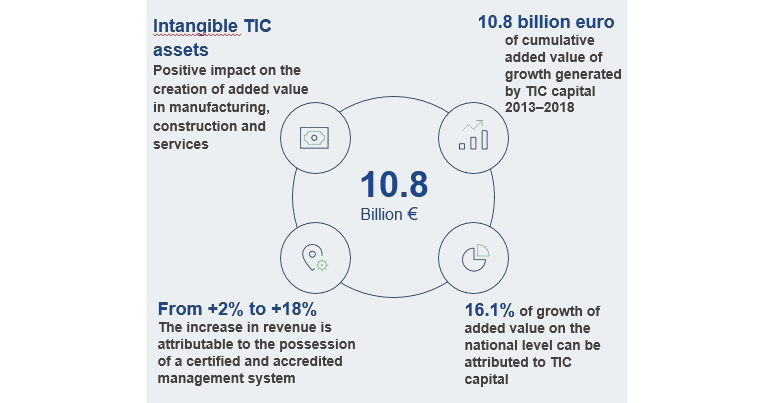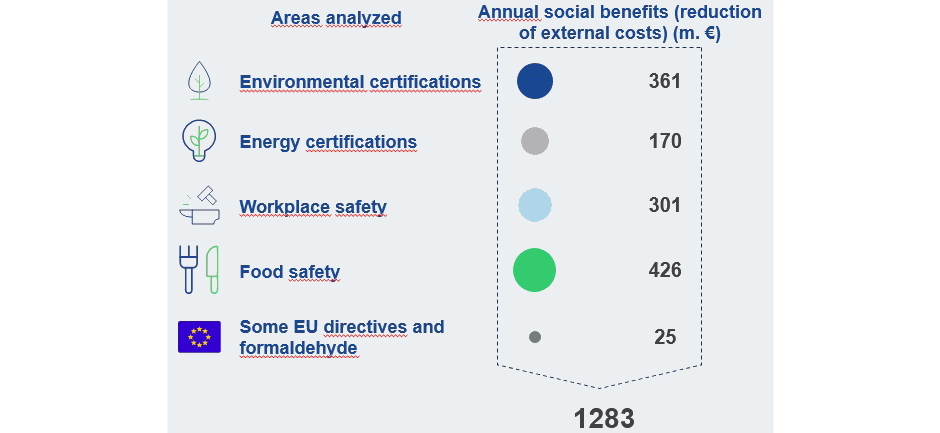Accreditation and certifications. Economic value and social benefits
The global Covid-19 outbreak imposes needs to accelerate the transition towards a model of sustainable development which, on a worldwide scale, involves all citizens and businesses. Government policies will have to take this on board, creating a favorable climate for private investment in which the Quality Infrastructure can perform a central role as a useful tool for assuring expected quality characteristics and for choosing sustainable products and services.
In Italy the enterprises involved in the global production chains already know the importance of international standards for enabling the interoperability of products and services, reducing transport costs and, in doing so, making world trade easier. But the tools for the Quality Infrastructure are also in themselves a value in the global market. Trust engendered in the markets by accreditation and conformity assessment, as by standardization and metrology, contributes to effective functioning, essential in containing the Covid-19 virus and for rebuilding our societies.
Within this context, with an in-depth economic study we have made an attempt in demonstrating the economic value for businesses and consumers of accredited conformity assessment activities.
In this study we examine the economic value of conformity assessments from various points of view.
- Firstly, the TIC world is analyzed with respect to the sector in question, defining the characteristics of the operators involved and the size of the market.
- Subsequently the benefits which these operators bring to the Italian economic system are examined and quantified by means of an analysis of the macro and micro economic aspects.
- Finally, an analysis is undertaken of the social benefits of these activities for the entire community regarding the environment and the health and safety of citizens. Thanks to the use of techniques borrowed from economic literature, it has been possible to quantify these benefits also in monetary terms.
Excluding the first and, in doing so, talking only about the benefits for enterprises and society we, taking as inputs the value of activities underataken by TIC operators, have reconstructed a measure defined “intangible TIC capital” which represents the stock of quality, knowledge and technology traceable to activities of certification, inspection, testing and calibration adopted in every sector [1]: intangible TIC capital has a positive and statistically significant impact in the creation of added value in all the macro sectors considered. The analysis quantifies how a 10% rise of TIC intangible stock capital results in an increase of around 0.5% in the total added value in the manufacturing, construction and services sectors. In aggregate terms, in the period 2013-2018 this constituted a contribution to growth of 16.1%; in other words, 16.1% of the added value growth in these three sectors can be attributed to TIC capital. In monetary terms, in the years 2013-2018, the TIC capital generated a cumulative added value of 10.8 billion euro [2].
An in-depth microeconomic analysis of the relation between the adoption of an accredited certified management system and economic performance confirmed the results described above. Businesses which use a certified and accredited management system (over 88,000 in Italy with revenue of some 1,400 billion euro, equal to 40% of the total economy) perform significantly better than those without certification. Applying a counterfactual method based on a comparison between certified and non-certified businesses but possessing similar characteristics, it transpires that accredited certification leads to a growth rate in revenue over the next two years of between 2% and 18% depending upon the sector in question and the standard applied, with more evident effects in the case of construction and services.
The impact on other balance sheet variables underlines that increases in production are accompanied by a rise in investment, a reduction of financial burdens and a greater capacity to generate cash-flow. These benefits do not result in increased operational costs, confirming the fact that costs relating to certification are in some way absorbed and rewarded by better corporate organization. A medium-term study conducted on a sample of companies with ISO 9001 certification showed that the performance discrepancy remained stable as much as ten years later.
Figure 1. Benefits for enterprises and for the economy

Along with the benefits for businesses described above there are a great many positives for society at large deriving from the application of standards and TIC activities. Experience has provided evidence of and quantified the contribution of certain segments of the Quality Infrastructure to society concerning the environment, health and safety. Analysis conducted examines and evaluates the benefits created by the reduction of negative factors [3] (less pollution, fewer illnesses, injuries and others) and of the related financial costs (external costs [4]) attributable to the TIC activities taken into consideration.
The overall results of the cases viewed reflect a major contribution made by the Quality Infrastructure in all its components in terms of social and environmental benefits, totaling around 1.3 billion euro per year. It is important to underline that the evidence presented regards a limited though significant number of examples related to the Quality Infrastructure, and leaves aside many others for reasons of information availability or which are not strictly relevant to the scope of this study. It is important to report that, within the areas taken into consideration, the social benefits are, on average, double the costs sustained by businesses to obtain and maintain certification (without counting the private benefits). Any expansion of the diffusion of the systems analyzed could increase the systemic effects reported contributing to sustainable growth.
Figure 2. Benefits for society at large

[1] This approach derives from awareness of the costs sustained by the economy for certifications, tests and calibrations, not as simple occasional expenses, but as investments in human effort, in patents, software and all other intangible expenses which support economic growth.
[3] In economic theory the term used is externalities, meaning an unintentional effect deriving from actions impacting production or consumption by a second party without direct transaction between them. These external effects may be positive or negative. The negative ones include activities which emit pollution into the air or which reduce business output, or those which alter productivity of persons collaborating in the productive process.
[4] The external cost is the economic quantification of a physical effect and it pre-supposes the choice of a value to give to human life, to the quality of the air and to health. The economic literature has developed a series of techniques to reach these goals and the evaluations of this study are based on those techniques.